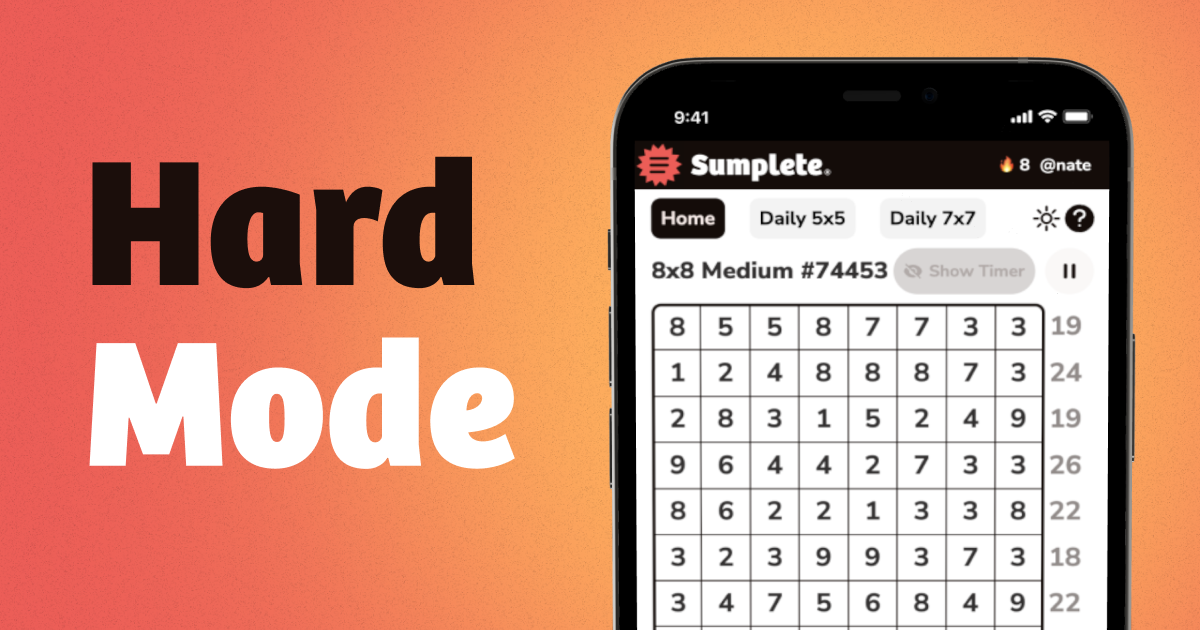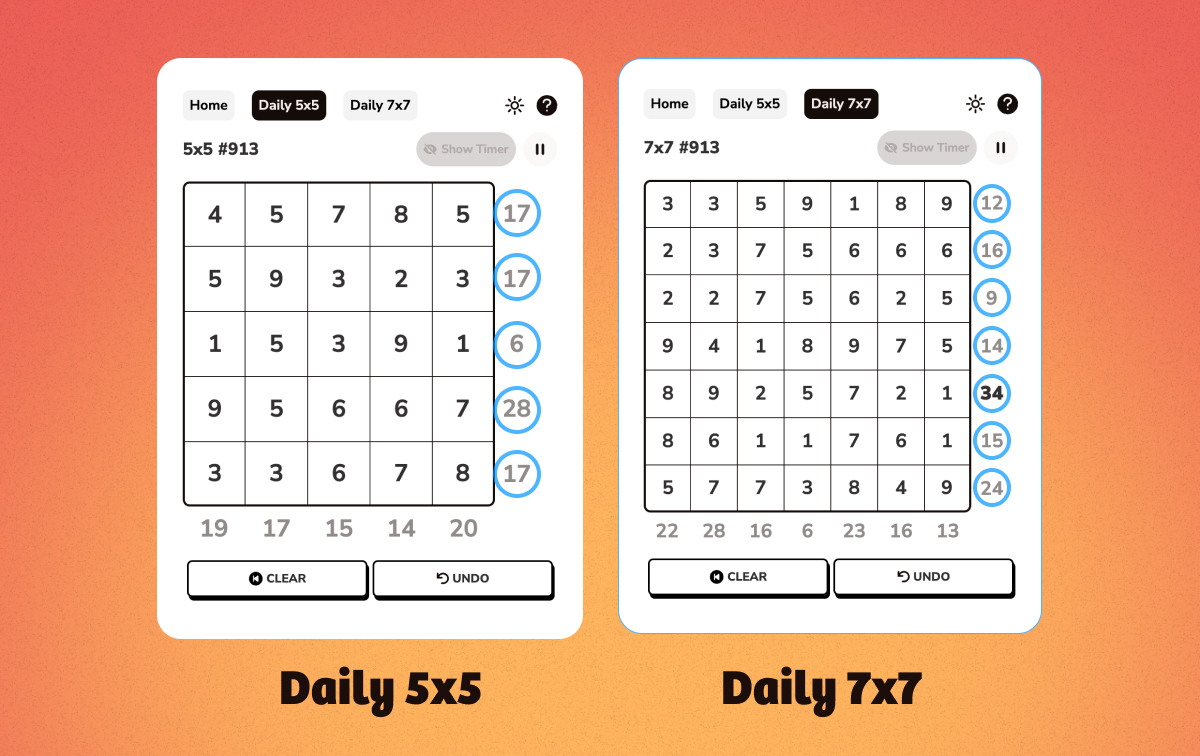Sumplete Hard Mode Guide: 7×7 Strategy & Pro Tips

← Back to Daily Number Puzzle Guide
Today, we will explore “hard mode” in greater detail and review a few strategies you can use next time you’re up for the challenge.
What does “Hard Mode” Mean in Sumplete?
“Hard mode” refers to the larger, more complex grids that Sumplete offers. Players can choose from a variety of Sumplete grid sizes and difficulty levels.
Newcomers will typically begin by attempting to solve the easier 3x3 and 4x4 boards. Those seeking a slightly more challenging experience will normally hone their skills on the medium-level 5x5 daily board or the 6x6 grid. Players seeking a true test of skill will turn to the 7x7, 8x8, and 9x9 boards, which can be played at Hard, Expert, and Master-level difficulties.
Games at the 7x7 level and above are naturally more difficult due to the increased number of intersections, higher residual sums per grouping, and fewer easy cell and grouping eliminations compared to the smaller grids.
Sumplete is just one of many number logic puzzles you can play daily.

How to Tackle 7x7 Grids: A 5-Step Guide
If you’re new, start with our how-to guide before tackling larger boards.
- Assess and Budget Sum Clues: Look at the sum clue target values for each row and column. Take inventory of the lowest and highest values.
- Check for Zero Sum Clues: It’s rare to find a grouping with a sum clue of “0” at the higher levels, but you never know! You may get lucky — if so, quickly eliminate all of the cells from the grouping.
- Eliminate Overages: Delete any cells with single values that exceed a corresponding sum clue. For example, if a sum clue for a row is 7, and the number “8” is in a cell within that row, eliminate the cell in question. This step makes solving for groupings with lower values a bit easier.
- Go Low, then High: After solving for the lower-value groupings, return to your higher values. Check for rows and columns that require the fewest cell eliminations to match the sum clue. For example, if a sum clue for a given row is 61 on a 7x7 board, there will be very few eliminations as the “difference clue” will equal 2, which means that a maximum of two cells will need to be eliminated.
- Solve Each Intersection: Avoid dead boards by selecting and eliminating cells that will allow each grouping to match its respective sum clue (vertically and horizontally). If you are confident in your cell selection for a specific grouping, click the sum clue for that row or column to quickly eliminate the remaining cells.
The Patterns That Win Hard Mode
There are a few patterns that, when detected by players, can be leveraged to identify which cells to eliminate and select:
| Pattern | How to Spot | Action |
|---|---|---|
| Complementary Pairs | A pair of numbers that equal the row or column’s sum clue. Example: Target = 10 with visible 4 and 6. |
Preserve the pair until intersecting clues confirm or reject it. Cross out other cells first. |
| Triples & Quads | Three or four numbers that add to larger targets like 15 or 16. | Keep the only valid combination to match the sum clue. Eliminate conflicting cells. |
| Residual Tracking | The running sum of a row or column approaches zero. | Avoid over-clearing — keep at least one candidate cell until intersections confirm placement. |
| Ceiling Checks | A sum clue is less than the two largest visible numbers combined. | Both numbers can’t remain. Eliminate one using intersecting line logic. |
| Crosshair Zeroing | A line hits a target sum of 0. | Immediately check intersecting lines for overages and adjust eliminations. |
Many of these strategies will feel familiar to Sudoku fans — see our Sumplete vs Sudoku comparison.
Worked Example: Solving a 7×7
Advanced Features: Auto-Mark & ‘Keep’ Circles
- What we mean by “bonus sums”: targets/rows flagged for extra challenge or scoring (e.g., starred lines).
- Strategy: treat bonus lines as late-game; avoid starving intersecting lines too early.
- Scoring/streak tip: finish bonus lines last to reduce mis-clears.
How do I Solve Sumplete Boards Faster?
Skilled Sumplete players can solve boards faster by focusing on the smallest targets first.
When possible, they will also click on the sum clue values to trigger batch eliminations after they’ve solved a line. They might also use various keyboard or mobile gestures to spend less time clicking individual cells with their mouse.
What are Some Tips to Grow My Sumplete Winning Streaks?
If your goal is to boost your Sumplete win streak while simultaneously reducing your solve time, here are two techniques you may want to implement during your next game:
- Bail early on bad openings: We’ve all been there. You got off to a rough start in the first few rows, and the strategies you initially attempted aren’t yielding any results. Stop trying to force a square peg into a round hole! Clear the board and pivot to a new opening move, perhaps starting with a different portion of the grid. This will get you back on course to extending your win streak faster than if you were to try to use brute force with your initial strategy for the rest of the game.
- Maintain a “Two-Lines From Zero” Rule: If you’re lucky enough to get a board with 0 for a sum clue, you should be able to solve two lines as a result of said blessing. A zero is easy — you just remove all of the numbers in that cell or grouping. BUT, after those eliminations have been made, check to see if the newly removed cells have helped demystify any of the intersecting lines.
What Sumplete Mistakes Should I Avoid?
- Over-clearing a line: It’s important to leave candidates or residuals (cells that could work in a given row or column) until you can either eliminate them from consideration or progress to the end of a game and take some educated guesses. Clearing lines in their entirety too early (over-clearing) can result in a dead board later in the game. Making this error means you run the risk of eliminating a candidate cell that was needed to win.
- Ignoring a Fresh Zero: Missed a "0" sum clue? That can come back to haunt you — immediately eliminating rows with zero sum clues can shave precious seconds off of your solve time!
- Not re-scanning residuals: If you forget to scan your candidates or residuals near the end of the game, you run the risk of letting time tick away even though the board has been solved. Make sure to cross off or circle the residual cells accordingly. Remember: the game won’t make the right moves for you just because you did the math in your head!
FAQ
Is 7×7 the hardest Sumplete?
No, 7x7 is not the hardest Sumplete board. Technically, the hardest Sumplete board is the 9x9 Master-level grid.
What’s a good 7×7 time?
Anywhere from 4 to 8 minutes is considered a good solve time for the 7x7 board.
Can I undo a move?
You can undo an elimination by clicking a cell twice. You can undo a selection by clicking the cell once.
How are hard boards generated?
All Sumplete boards feature randomized sequences of numbers that are generated with ChatGPT. At the Hard level, 49 cells on the 7x7 board are generated with the same randomness as the easier grids and the Master-level 9x9 boards
Are you up to the test?
Ready to give Sumplete’s Hard mode a try? Click below to play!